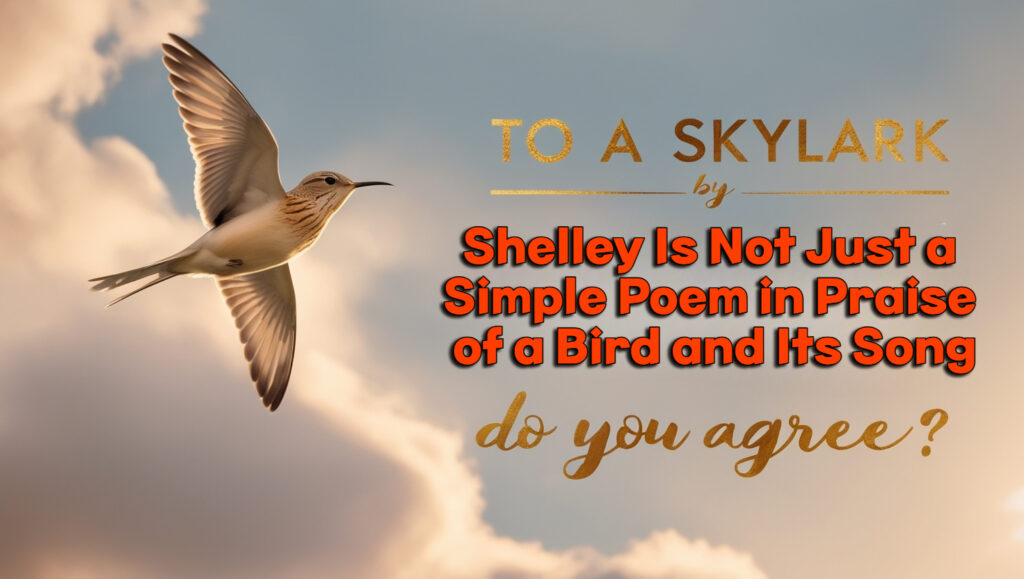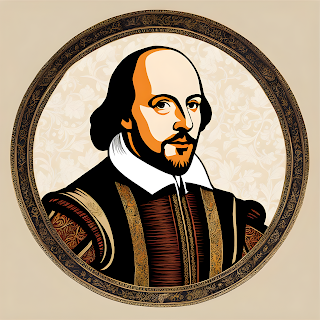
To a Skylark by Shelley Is Not Just a Simple Poem in Praise of a Bird and Its Song—Do You Agree?
Percy Bysshe Shelley’s To a Skylark is often read as a beautiful, lyrical poem that praises the skylark’s joyous flight and melodic song. However, to view the poem simply as an ode to a bird would be to miss the depth and complexity that underpins its apparent simplicity. While the skylark and its song are the central images of the poem, Shelley uses the bird as a vehicle to explore deeper philosophical ideas about joy, creativity, nature, and the limitations of human experience. Far from being just a simple praise of a bird, To a Skylark is a profound meditation on the human condition, the desire for transcendence, and the nature of artistic inspiration.
This analysis will argue that To a Skylark transcends its initial appearance as a straightforward nature poem, offering instead a rich reflection on joy, freedom, and the tension between the ideal and the real.
The Skylark as a Symbol of Transcendence and Idealism
At the outset of the poem, Shelley elevates the skylark beyond the realm of the ordinary by referring to it as a “blithe Spirit.” This description immediately positions the skylark not as a physical bird but as something ethereal and transcendent. The skylark is not just an ordinary bird; it is a symbol of freedom, joy, and inspiration, representing an ideal state of being that humans can only aspire to.
The poem’s opening lines make it clear that the skylark is meant to embody something more than just a natural phenomenon:
“Hail to thee, blithe Spirit!
Bird thou never wert—”
By calling the skylark a “blithe Spirit,” Shelley suggests that the bird transcends the limitations of the physical world. The skylark’s song is not merely the product of a biological creature; it is an expression of pure joy, free from the sorrows and struggles of human life. This sense of transcendence is reinforced throughout the poem as the bird soars higher and higher, disappearing from sight but leaving its song behind. The skylark’s ability to fly so far above the earth and to sing continuously as it does so becomes a metaphor for an ideal state of existence—one that is free from pain, fear, and limitation.
Shelley contrasts the skylark’s ideal state with the condition of humanity. While the skylark exists in a state of perfect joy, humans are bound by sorrow and imperfection. Shelley laments:
“We look before and after,
And pine for what is not.”
This line encapsulates the fundamental difference between the skylark and human beings. Unlike the skylark, which exists fully in the present moment, humans are plagued by regrets about the past and anxieties about the future. This inability to live in the present prevents humans from experiencing the pure joy that the skylark embodies. In this way, the skylark becomes a symbol of an ideal state of existence—one that is free from the burdens of human thought and emotion.
The Skylark’s Song as an Expression of Ideal Joy
While the skylark’s flight is a symbol of transcendence, its song becomes a metaphor for ideal joy and artistic inspiration. Shelley repeatedly emphasizes that the skylark’s song is spontaneous and unpremeditated:
“In profuse strains of unpremeditated art.”
This description highlights the skylark’s ability to express joy without effort or forethought. The bird’s song flows naturally and abundantly, suggesting a kind of creative energy that is free from the limitations of human art. Unlike human poetry, which requires labor and thought, the skylark’s song is pure and unencumbered, a perfect expression of joy.
Shelley contrasts the skylark’s song with human creativity, which is often limited by the constraints of thought, experience, and emotion. While the skylark’s song is a perfect expression of joy, human poetry is often tinged with sorrow and imperfection. This tension between the ideal and the real is central to Shelley’s understanding of art and creativity. The skylark becomes a symbol of the kind of artistic expression that Shelley aspires to—a spontaneous, joyful creation that transcends the limitations of human experience.
The Limits of Human Understanding
One of the central themes of To a Skylark is the idea that humans are limited in their ability to understand and experience the kind of joy and freedom that the skylark represents. Throughout the poem, Shelley acknowledges that the skylark’s existence is beyond human comprehension. While the poet can hear the bird’s song, he cannot fully grasp the source of its joy or the nature of its existence. This sense of mystery is emphasized by the bird’s disappearance into the sky—though the skylark’s song continues, the bird itself becomes invisible, symbolizing the distance between the ideal and the real.
Shelley writes:
“What thou art we know not;
What is most like thee?”
These lines express the poet’s frustration with the limits of human understanding. The skylark’s joy is something that humans can only glimpse through metaphor and comparison, but it remains ultimately out of reach. The poet compares the skylark’s song to a series of beautiful and joyful images from nature—a cloud of fire at sunset, a rose hidden in its leaves, and a glowworm in the night—but none of these comparisons fully capture the essence of the bird’s joy. This inability to fully understand or express the skylark’s joy reinforces the idea that the bird represents an ideal that humans can aspire to but never fully attain.
The Tension Between Idealism and Reality
Throughout To a Skylark, Shelley grapples with the tension between idealism and reality. The skylark represents an ideal state of joy and freedom, but Shelley is keenly aware that this ideal is out of reach for humans. While the poet longs to experience the kind of joy that the skylark embodies, he recognizes that human existence is defined by sorrow, fear, and imperfection.
This tension is encapsulated in the poet’s plea to the skylark in the final stanzas of the poem:
“Teach me half the gladness
That thy brain must know,
Such harmonious madness
From my lips would flow.”
Here, Shelley expresses his desire to learn from the skylark, to capture even a fraction of the bird’s joy and spontaneity in his own poetry. However, the poet also acknowledges that human creativity is always tinged with sorrow and imperfection. While the skylark’s song is pure and untainted by fear or regret, human art is shaped by the limitations of human experience.
In this sense, To a Skylark is a meditation on the limits of human creativity and the impossibility of achieving the ideal. Shelley recognizes that while the poet can aspire to the kind of spontaneous, joyful creation that the skylark embodies, he can never fully achieve it. This recognition of the tension between idealism and reality is central to the poem’s philosophical depth.
Conclusion
While To a Skylark may initially appear to be a simple poem in praise of a bird and its song, a deeper reading reveals that it is much more than that. Shelley uses the skylark as a symbol of transcendence, joy, and artistic inspiration, exploring profound philosophical themes about the nature of human experience, the limits of understanding, and the tension between the ideal and the real. The skylark becomes a symbol of the perfect joy and creativity that humans can aspire to but never fully attain, and the poem becomes a meditation on the limitations of human existence.
Through its rich imagery, lyrical beauty, and philosophical depth, To a Skylark transcends its surface simplicity, offering a profound reflection on the nature of joy, freedom, and the human longing for transcendence. In this sense, the poem is far more than just a simple ode to a bird—it is a timeless exploration of the human condition and the desire for something beyond the ordinary.

